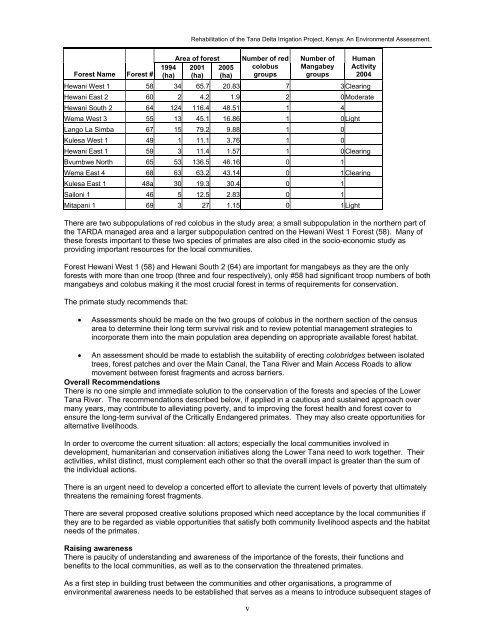Tana Delta Irrigation Project, Kenya: An Environmental Assessment
Tana Delta Irrigation Project, Kenya: An Environmental Assessment
Tana Delta Irrigation Project, Kenya: An Environmental Assessment
You also want an ePaper? Increase the reach of your titles
YUMPU automatically turns print PDFs into web optimized ePapers that Google loves.
Rehabilitation of the <strong>Tana</strong> <strong>Delta</strong> <strong>Irrigation</strong> <strong>Project</strong>, <strong>Kenya</strong>: <strong>An</strong> <strong>Environmental</strong> <strong>Assessment</strong>.<br />
Forest Name Forest #<br />
1994<br />
(ha)<br />
Area of forest<br />
2001<br />
(ha)<br />
2005<br />
(ha)<br />
Number of red<br />
colobus<br />
groups<br />
v<br />
Number of<br />
Mangabey<br />
groups<br />
Human<br />
Activity<br />
2004<br />
Hewani West 1 58 34 65.7 20.83 7 3Clearing<br />
Hewani East 2 60 2 4.2 1.9 2 0Moderate<br />
Hewani South 2 64 124 116.4 48.51 1 4<br />
Wema West 3 55 13 45.1 16.86 1 0Light<br />
Lango La Simba 67 15 79.2 9.88 1 0<br />
Kulesa West 1 49 1 11.1 3.76 1 0<br />
Hewani East 1 59 3 11.4 1.57 1 0Clearing<br />
Bvumbwe North 65 53 136.5 46.16 0 1<br />
Wema East 4 68 63 63.2 43.14 0 1Clearing<br />
Kulesa East 1 48a 30 19.3 30.4 0 1<br />
Sailoni 1 46 5 12.5 2.83 0 1<br />
Mitapani 1 69 3 27 1.15 0 1Light<br />
There are two subpopulations of red colobus in the study area; a small subpopulation in the northern part of<br />
the TARDA managed area and a larger subpopulation centred on the Hewani West 1 Forest (58). Many of<br />
these forests important to these two species of primates are also cited in the socio-economic study as<br />
providing important resources for the local communities.<br />
Forest Hewani West 1 (58) and Hewani South 2 (64) are important for mangabeys as they are the only<br />
forests with more than one troop (three and four respectively), only #58 had significant troop numbers of both<br />
mangabeys and colobus making it the most crucial forest in terms of requirements for conservation.<br />
The primate study recommends that:<br />
• <strong>Assessment</strong>s should be made on the two groups of colobus in the northern section of the census<br />
area to determine their long term survival risk and to review potential management strategies to<br />
incorporate them into the main population area depending on appropriate available forest habitat.<br />
• <strong>An</strong> assessment should be made to establish the suitability of erecting colobridges between isolated<br />
trees, forest patches and over the Main Canal, the <strong>Tana</strong> River and Main Access Roads to allow<br />
movement between forest fragments and across barriers.<br />
Overall Recommendations<br />
There is no one simple and immediate solution to the conservation of the forests and species of the Lower<br />
<strong>Tana</strong> River. The recommendations described below, if applied in a cautious and sustained approach over<br />
many years, may contribute to alleviating poverty, and to improving the forest health and forest cover to<br />
ensure the long-term survival of the Critically Endangered primates. They may also create opportunities for<br />
alternative livelihoods.<br />
In order to overcome the current situation: all actors; especially the local communities involved in<br />
development, humanitarian and conservation initiatives along the Lower <strong>Tana</strong> need to work together. Their<br />
activities, whilst distinct, must complement each other so that the overall impact is greater than the sum of<br />
the individual actions.<br />
There is an urgent need to develop a concerted effort to alleviate the current levels of poverty that ultimately<br />
threatens the remaining forest fragments.<br />
There are several proposed creative solutions proposed which need acceptance by the local communities if<br />
they are to be regarded as viable opportunities that satisfy both community livelihood aspects and the habitat<br />
needs of the primates.<br />
Raising awareness<br />
There is paucity of understanding and awareness of the importance of the forests, their functions and<br />
benefits to the local communities, as well as to the conservation the threatened primates.<br />
As a first step in building trust between the communities and other organisations, a programme of<br />
environmental awareness needs to be established that serves as a means to introduce subsequent stages of

















